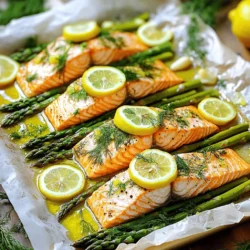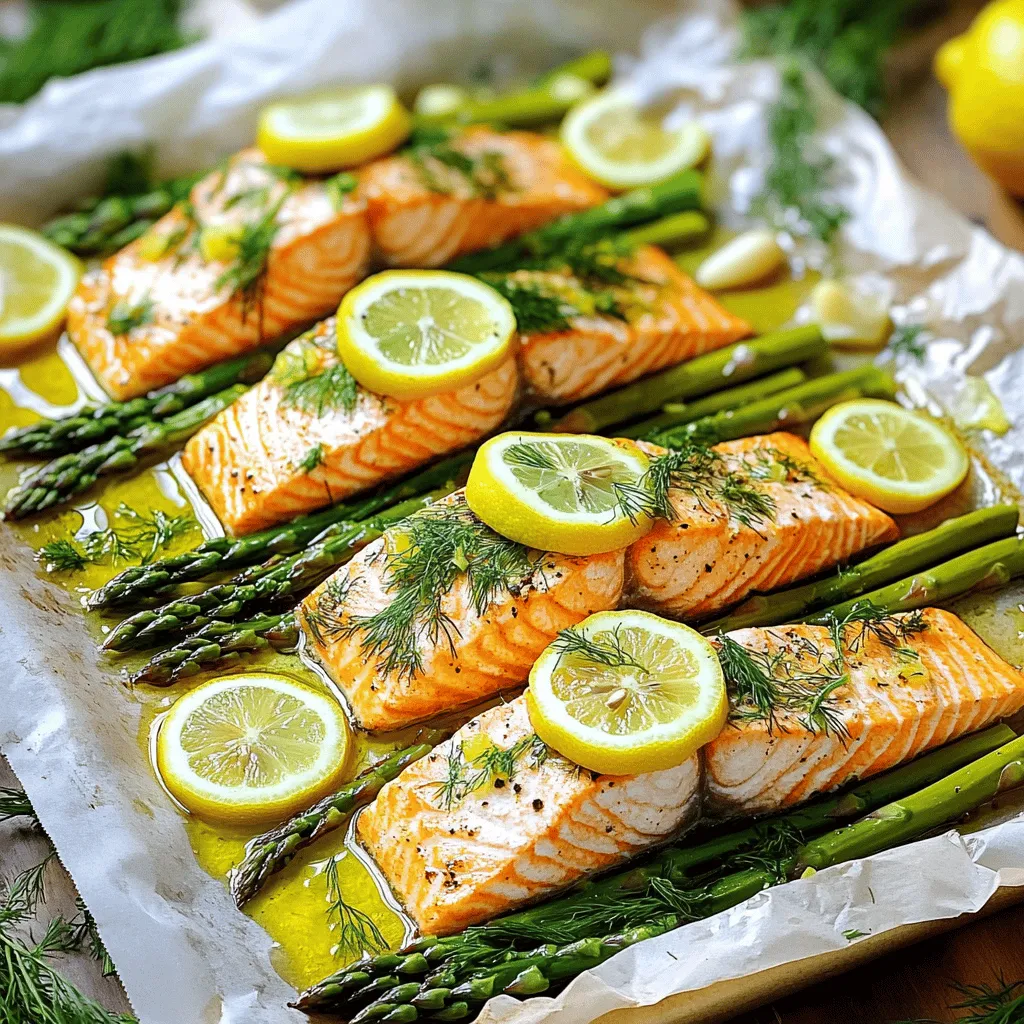Ready to enjoy a one-pan meal that’s quick and tasty? My Sheet Pan Lemon Dill Salmon and Asparagus Delight is just what you need! This easy recipe combines fresh salmon and crunchy asparagus with zesty lemon and dill for a burst of flavor. Whether you’re a busy parent or a cooking newbie, you’ll find simple steps and helpful tips to create a delicious dish. Let’s dive into the details together!
Ingredients
List of Ingredients
- 4 salmon fillets (about 6 ounces each)
- 1 bunch of asparagus, trimmed
- 2 tablespoons olive oil
- 2 lemons, one sliced, one juiced
- 2 tablespoons fresh dill, chopped (or 1 tablespoon dried dill)
- 3 cloves garlic, minced
- Salt and pepper to taste
- 1 teaspoon paprika (optional)
Ingredient Substitutions
If you can’t find fresh dill, use dried dill. It’s easy to swap. You can also use other herbs like parsley or thyme. For garlic, you may use garlic powder instead. If you want, replace salmon with another fish, like trout or cod. If you need a lighter option, use chicken breast instead of salmon.
Tips for Choosing Fresh Salmon and Asparagus
When picking salmon, look for bright, shiny skin. The flesh should be firm and moist. It should not smell fishy. As for asparagus, choose spears that are bright green and firm. Avoid any that are limp or have dark spots. Fresh asparagus should snap easily when bent. These tips help ensure your dish tastes great!
Step-by-Step Instructions
Prepping the Oven and Sheet Pan
First, I preheat my oven to 400°F (200°C). This temperature cooks the salmon just right. I line a large sheet pan with parchment paper. This step keeps the salmon and asparagus from sticking. It also makes cleanup easy.
Making the Lemon Dill Marinade
In a small bowl, I mix together the olive oil, lemon juice, minced garlic, and chopped dill. I add salt and pepper to taste. If I want more color, I sprinkle in paprika. This marinade gives the dish a bright, fresh flavor.
Arranging Salmon and Asparagus on the Sheet Pan
Next, I place the salmon fillets in the center of the sheet pan. I pour half of the marinade over the salmon. It’s important to coat the salmon well. Then, I arrange the trimmed asparagus around the salmon. I drizzle the remaining marinade over the asparagus. I finish by sprinkling more salt and pepper on top.
Baking Instructions
I bake the sheet pan in the preheated oven for about 15-20 minutes. I check if the salmon flakes easily with a fork. The asparagus should be tender yet crisp. Once done, I remove it from the oven and let it cool for a minute. This dish looks great served directly from the sheet pan!
Tips & Tricks
How to Ensure Perfectly Cooked Salmon
To cook salmon just right, focus on time and temperature. Bake the salmon at 400°F (200°C) for 15-20 minutes. Check if the salmon flakes easily with a fork. If it does, it’s ready! A meat thermometer can help. Aim for an internal temperature of 145°F (63°C). Cooking time can vary based on thickness. Thicker fillets may need a few extra minutes.
Enhancing Flavor with Additional Herbs or Spices
You can add more flavor to your dish by using fresh herbs. Try parsley, basil, or thyme for a different taste. A pinch of red pepper flakes can add a bit of heat. If you like smokiness, consider smoked paprika. Mix and match to find the flavors you love best.
Serving Suggestions and Pairings
This dish pairs well with a fresh side salad or quinoa. The lightness of the salad balances the rich salmon. For a fun twist, serve with a dollop of tzatziki sauce. You could also add roasted potatoes for a heartier meal. Garnish with extra lemon slices and dill for a pop of color and taste. Enjoy your meal straight from the pan for an easy clean-up!

Variations
Ingredient Swaps for Different Vegetables
You can swap asparagus for other veggies. Try green beans, zucchini, or bell peppers. Each vegetable brings a new taste and texture. Make sure to cut them to similar sizes for even cooking. Roasted broccoli or Brussels sprouts also work well. They add crunch and flavor to your dish.
Alternatives to Lemon and Dill for Flavor
If you want a twist, use lime and cilantro instead. This fresh combo gives a zesty kick. You can also try orange juice and thyme for a sweeter profile. Garlic and rosemary can add depth too. Experiment with different herbs to find your favorite mix.
Making it a Complete Meal with Grains or Sides
To make this dish a full meal, add grains like quinoa or brown rice. These sides soak up the flavors well. You can also serve with a light salad. A simple green salad with vinaigrette pairs nicely. This adds freshness and balances the meal.
Storage Info
How to Store Leftovers
To keep your leftovers fresh, place them in an airtight container. Make sure to cool the salmon and asparagus first. You can store them in the fridge for up to three days. If you want to enjoy them later, freezing is a good option too.
Reheating Tips for Best Results
When you’re ready to eat, reheat gently. Use an oven set to 350°F (175°C) for the best texture. Cover the dish with foil to keep it moist. You can also use a microwave. Heat in short bursts, checking often to avoid overcooking.
Freezing Salmon and Asparagus
If you want to freeze your salmon and asparagus, wrap them tightly in plastic wrap. Then, place them in a freezer-safe bag. They can last up to three months. When ready to eat, thaw in the fridge overnight before reheating. This keeps your meal tasty and safe.
FAQs
How long does it take to cook salmon and asparagus on a sheet pan?
It takes about 15 to 20 minutes to cook salmon and asparagus on a sheet pan. The oven should be set to 400°F (200°C) for even cooking. The salmon will be perfectly flaky and the asparagus bright and tender.
Can I use frozen salmon for this recipe?
Yes, you can use frozen salmon. Just make sure to thaw it first. You can thaw salmon in the fridge overnight or use the quick method. Place it in a sealed bag and submerge it in cold water for about an hour.
What temperature should salmon be cooked to?
Salmon should be cooked to an internal temperature of 145°F (63°C). This ensures the fish is safe to eat and still moist. Use a food thermometer for the best results.
Can I use other types of fish instead of salmon?
Absolutely! You can use other fish like trout or cod. Just adjust the cooking time as needed since different fish may cook faster or slower than salmon.
How do I know when the salmon is done cooking?
You can tell the salmon is done when it flakes easily with a fork. The flesh should look opaque and not translucent. If you have a food thermometer, check for an internal temperature of 145°F (63°C).
In this post, we covered all you need to know about cooking salmon and asparagus. You learned about fresh ingredients, step-by-step baking, and handy tips for perfect results. I shared variations to keep your meals exciting and storage tips to save leftovers. Remember, cooking can be simple and fun. With these insights, you can create delicious meals to share or enjoy alone. Embrace your kitchen skills, and let your creativity shine!

